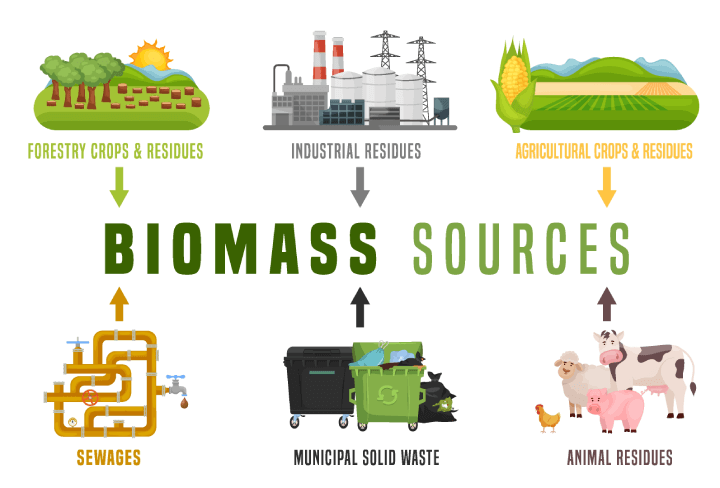5 Things to Know about Biomass: From Photosynthesis to Power
Educational | 22-08-2023 | By Gary Elinoff
Derived from the biological processes of life, biomass encompasses both plant and animal matter. Historically, humans have utilized biomass for energy, such as burning wood. In modern times, its role in global energy supply has expanded, with sources like corn being used to produce alcohol for various applications, including electricity generation. According to the International Energy Association[4], bioenergy is a leading renewable energy source, contributing to over 6% of the global energy supply, and its significance is expected to grow.
What is Biomass in Simple Terms?
But first, let's break down the concept of biomass for a clearer understanding.

Plants are the precursors of all biomass, and the sun is the source of food energy for plants. Photosynthesis is nature’s own version of the silicon solar cell. Through this process, plants absorb sunlight and employ this energy from the sun to forge carbon dioxide (CO2) and water into glucose and oxygen.
Sunlight
6 CO2 + 6 H2O -------→ C6H1206 + 6 O2
From there, other energy-rich compounds are formed, empowering the plant’s growth and reproduction. Some of the plants are eaten by herbivores, which are eaten by carnivores, and these plants and animals of every sort comprise the biomass, the web of life.
If scientists and engineers could duplicate photosynthesis, the whole discussion of renewables would take a radical turn. There would be no need to derive energy from biomass because we could direct our version of photosynthesis to produce alcohol, ammonia or any other energy-rich compound that is easy to store, easy to transport and has a long shelf life.
But this ability, the Holy Grail of energy scientists, is not yet at hand. However, we do have the option of indirectly obtaining the sun’s energy through the intermediary of the biomass.
How is Energy Obtained from BioMass?
Now that we understand what biomass is let's delve into how we can extract energy from it.
Biopower technologies harness renewable biomass fuels to generate heat and electricity, mirroring processes used with fossil fuels. As outlined in Biopower Basics by the Federal Office of Energy Efficiency and Renewable Energy, the primary methods to release energy from biomass for biopower include:
- Direct Combustion: Biomass undergoes combustion in a boiler to produce high-pressure steam. This steam activates a series of turbine blades, causing rotation. The turbine's movement powers a generator, generating electricity. Biomass can also co-fire with coal in an existing power plant furnace, reducing the coal quantity needed for electricity production.
- Bacterial Decomposition (Anaerobic Digestion): Organic waste, like animal dung or human sewage, is stored in oxygen-free tanks or digesters. Anaerobic bacteria decompose this material, producing methane and other byproducts, forming a renewable natural gas. This gas can then be purified and utilised for electricity generation.
- Conversion to a Gas or Liquid Fuel: Biomass can transform into a gaseous or liquid fuel via gasification and pyrolysis. Gasification exposes biomass to high temperatures with minimal oxygen, producing synthesis gas (syngas) comprising mainly carbon monoxide and hydrogen. This gas can replace natural gas in a combined-cycle gas turbine. Pyrolysis, on the other hand, heats biomass in an oxygen-free environment, producing a crude bio-oil. This bio-oil can substitute fuel oil or diesel in furnaces, turbines, and engines, generating electricity.
What are some of the BioMass Feedstocks used to Produce energy?
As enumerated in National Geographic[1], a wide range of possible Biomass progenitors can be used to produce useful energy.
 Possible sources of biomass used to produce renewable energy. The top row displays switchgrass, copra (coconut), cotton, and jatropha. The middle row showcases municipal solid waste (msw), sunflowers, palm nuts, and canola. The bottom row features wheat, sugar cane, wood, and rice as leading biomass feedstocks. Image courtesy of National Geographic
Possible sources of biomass used to produce renewable energy. The top row displays switchgrass, copra (coconut), cotton, and jatropha. The middle row showcases municipal solid waste (msw), sunflowers, palm nuts, and canola. The bottom row features wheat, sugar cane, wood, and rice as leading biomass feedstocks. Image courtesy of National Geographic
These feedstocks include (top row) switchgrass, copra (coconut), cotton, and jatropha; (middle row) municipal solid waste (msw), sunflowers, palm nuts, and canola; (bottom row) wheat, sugar cane, wood, and rice.
What are the Advantages of Energy Derived from Biomass?
Utilizing biomass for energy has several benefits, especially when considering the environment.
The web of life encompasses the carbon cycle. When a plant or animal dies, its carbon content may be absorbed into the soil, where, as in the famous example of the dinosaurs, it may end up in various forms, such as coal, where it can be sequestered for millions of years. If it is burned to create energy, long dormant carbon will be released into the atmosphere in the form of CO2, increasing the carbon dioxide component of air, which many believe to be the cause of global warming.
Using biomass as an energy source unleashes a more carbon-neutral pattern of events. Photosynthesis removes atmospheric CO2 from the atmosphere and uses it to produce plants, as described earlier. When plant biomass is used to produce energy, the CO2 returns to the atmosphere.
The critical difference is that the dinosaur-age coal has been sequestered for aeons – its carbon has been effectively removed from the carbon cycle. Burning releases the long-dormant carbon into the atmosphere for a net gain in atmospheric carbon dioxide. Burning biomass, on the other hand, is demonstratively carbon neutral. In a continuing cycle, the amount of carbon released into the atmosphere equals the amount drawn into the plant previously by photosynthesis.
The bottom line is that energy derived through the use of biomass, such as plants, introduces no new net CO2 into the atmosphere.
What are the Risks of Biomass?
While biomass offers numerous advantages, it's essential to also consider the potential risks and challenges.
The use of biomass for energy generation is not completely risk-free. As detailed by National Geographic[1], “Most biomass requires arable land to develop. This means that land used for biofuel crops such as corn and soybeans is unavailable to grow food or provide natural habitats.”
The land use yield is strikingly low. As the National Geographic report points out, only “About 1,515 liters (400 gallons) of ethanol is produced by an acre of corn”. As described by the US Department of Energy [5], a gallon of ethanol only stores 67% of the energy that a gallon of gasoline does. 67% of 400 gallons is 268 gallons.
According to the USDA[6], an acre of farmland yields about 177 bushels of corn, which can feed many hungry people. That’s a lot of food to sacrifice for the equivalent of 268 gallons of gasoline. Despite this glaring inefficiency, ethanol is a major component of the “gasoline” used to fill up motor vehicles in the US today. According to the US Department of Energy[3], “Today, more than 95% of gasoline is E-10, a blend of 10 percent ethanol and 90 percent gasoline.”
However, the report goes on to state that the DOE (Department of Energy) is exploring how to produce “cellulosic ethanol” and other “biofuels” from non-food sources.
Unless biofuels are derived from “waste material”, such as sewage or crop residues, including corn cobs and plant stalks, food production isn’t the only potential problem related to producing energy from biomass. While very little food is produced from tropical rain forests such as those that cover Brazil, this largely virgin land is essential for maintaining that carbon balance in the Earth’s biosphere. Vital planetary resources such as rainforests must not be sacrificed on the altar of energy.
The exploitation of biomass has great potential for providing vital energy without degrading the climate. While efforts such as the production of ethanol from corn is a great first step, for progress to continue, methods that neither impose degradation of the natural environment nor negatively impact food production must be furthered, lest biomass development ends up causing more problems than it solves.
References
- Biomass Energy - National Geographic
- Biopower Basics - Energy.GOV, Office of Energy Efficiency and Renewable Energy
- Biomass Basics: The Facts About Bioenergy - US Department of ENERGY
- Bioenergy - IEA. International Energy Agency
- Alternate Fuels Data Center – US Department of Energy, Energy Efficiency & Renewable Energy
- National Agricultural Statistics Service – United States Department of Agriculture

